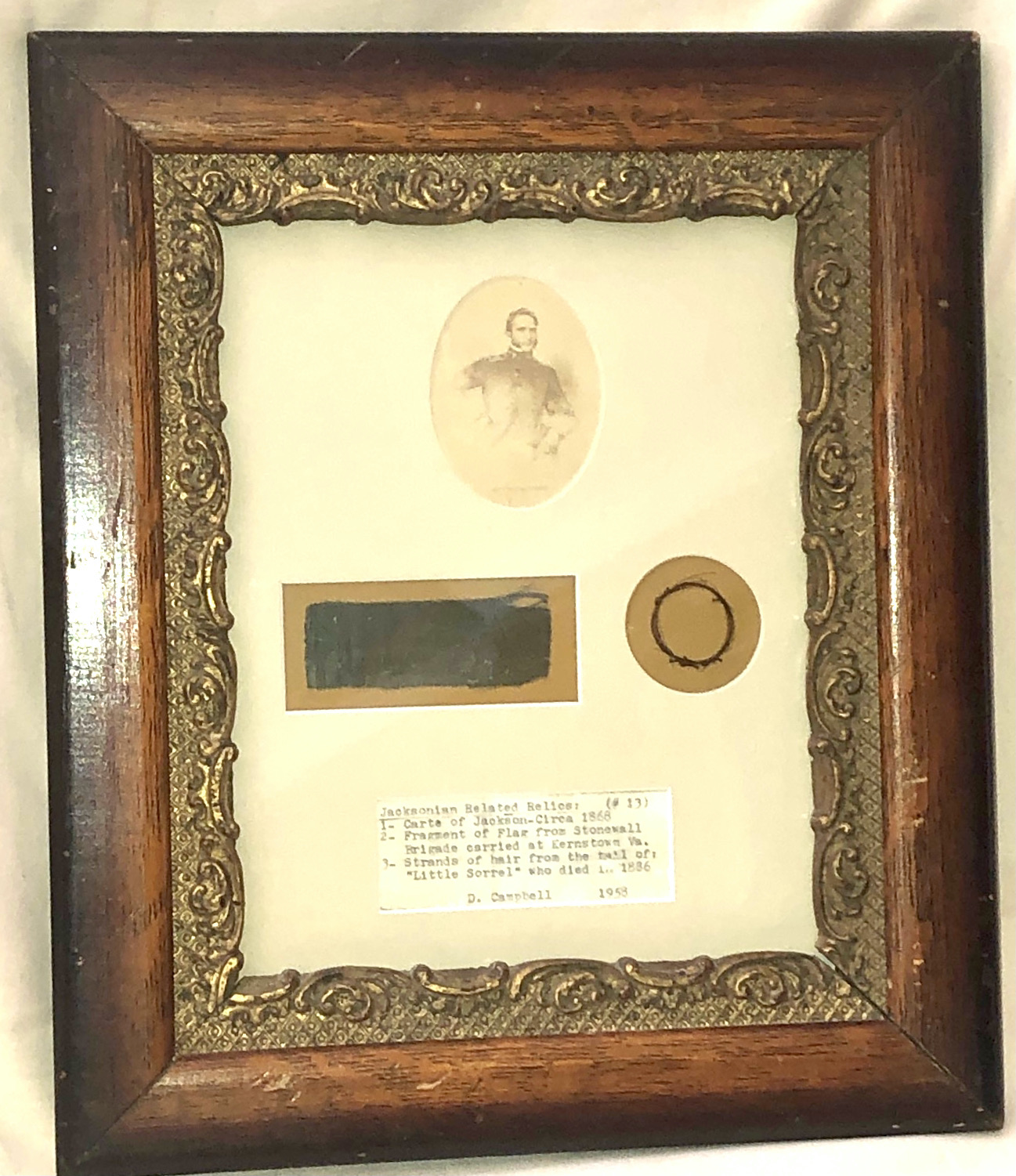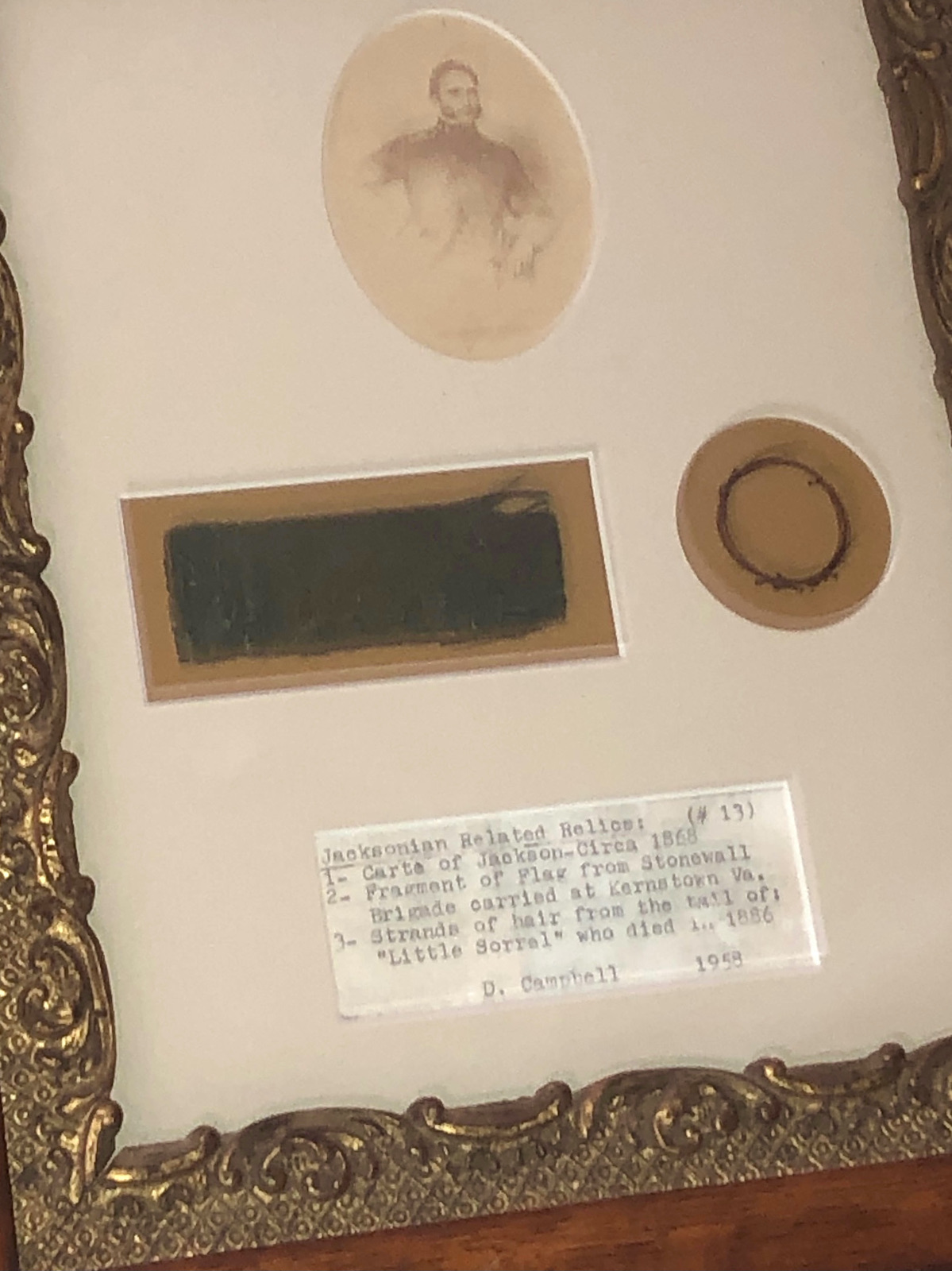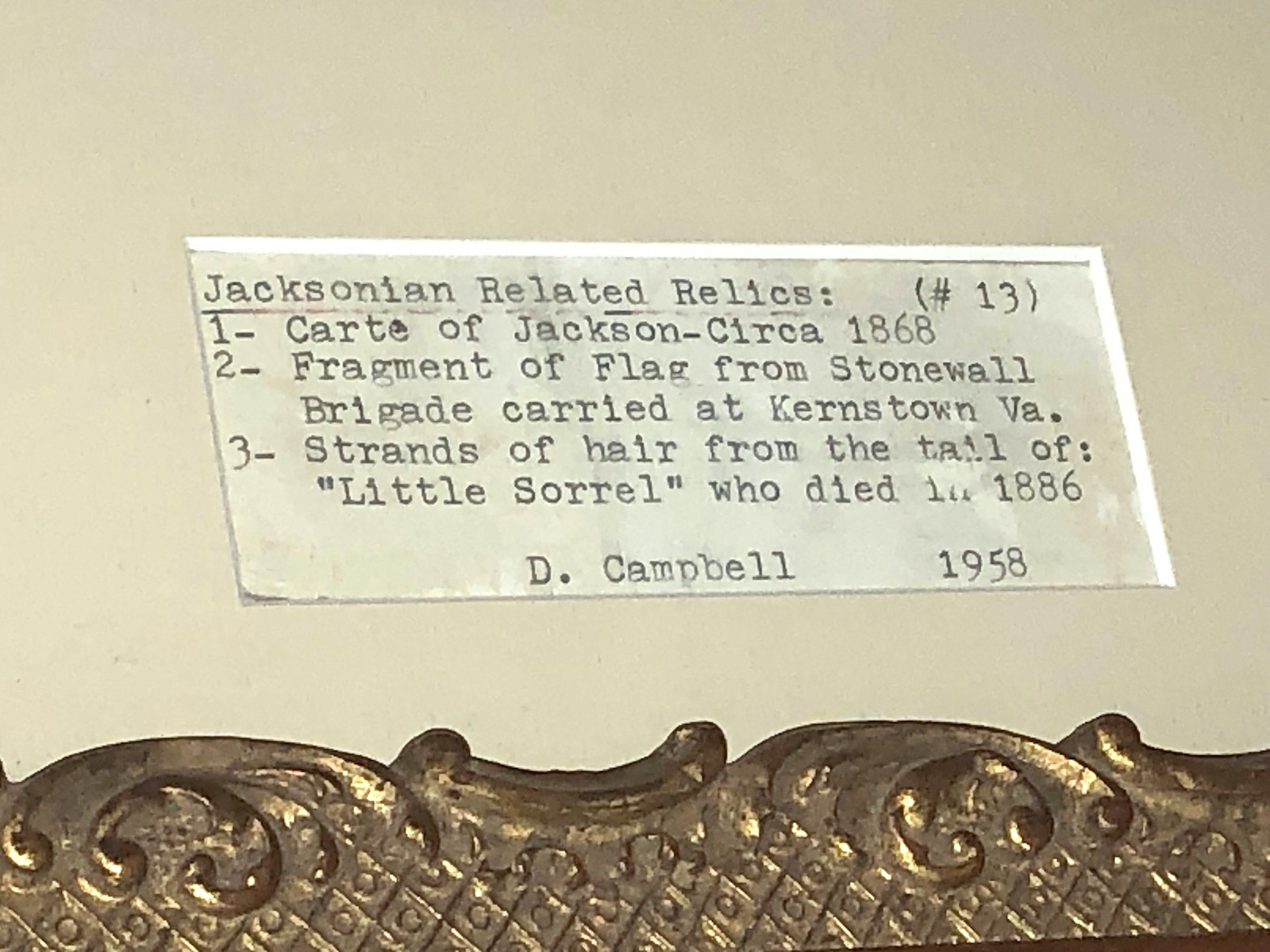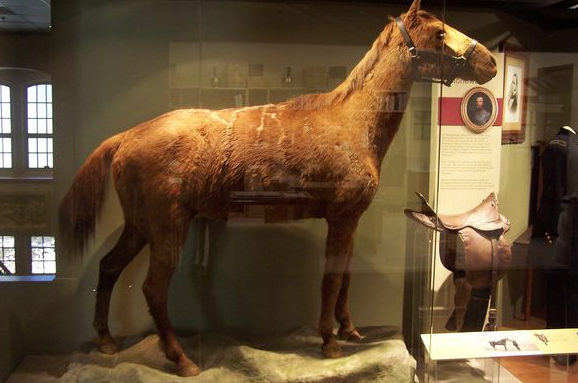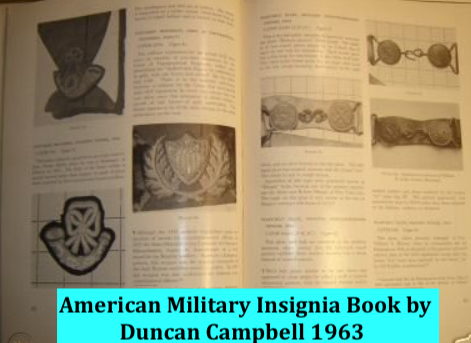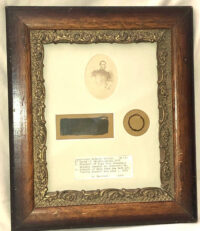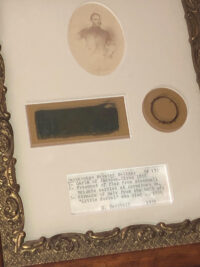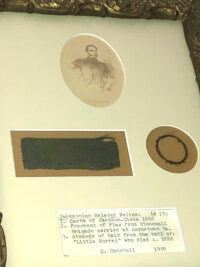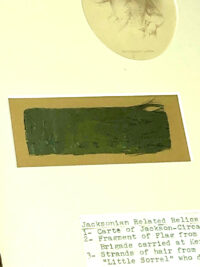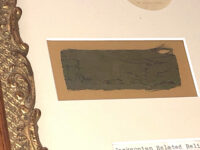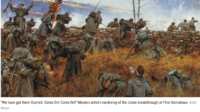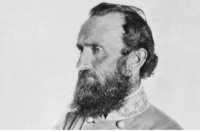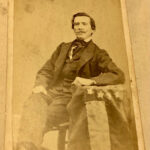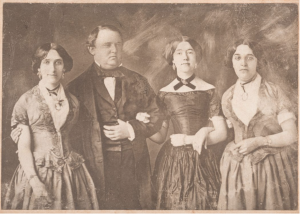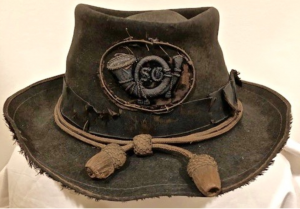Decoratively Mounted Section of the Flag of Stonewall Jackson’s 1862 Command at Kernstown, Virginia and Mane Hair from Jackson’s Horse, Little Sorrel
SOLD
Decoratively Mounted Section of the Flag of Stonewall Jackson’s 1862 Command at Kernstown, Virginia and Mane Hair from Jackson’s Horse, Little Sorrel – Apparently collected by renown Civil War insignia expert, J. Duncan Campbell, in the 1950s, this group of “Jacksonian Related Relics”, as they were entitled by Campbell, include the following: a Carte de Visite featuring an engraving or lithograph of T.J. Jackson, in a U.S. Army uniform, around 1858 (note Duncan’s erroneously listed date of “1968”, on his typed enumeration); a blue silk segment of Confederate Gen. Jackson’s regimental flag, taken during the 1862 Kernstown, Va. campaign; a group of mane hairs from Jackson’s wartime mount, Little Sorrel. Duncan Campbell identified these items in a typed list, created by him, in 1958; that list accompanies the decoratively arranged artifacts, in a c. 1880 frame – we just obtained this intriguing group from an old collection; we believe that the former owner had the artifacts and Campbell’s list, framed. The flag segment, which measures – L: 3.25”; W – 1”, is composed of blue silk; the brown mane hair of Little Sorrel, is entwined in a ring that measures about 1” in diameter. This is a significantly unique grouping of items related to one of the Confederacy’s most iconic commanders, gathered by one of the “founders” of Civil War militaria research.
Measurements: Frame size – H: 14”; W: 12”; Sight size – H: 9.5”; W: 7.25”
Battle of Kernstown: Stonewall Jackson’s Only Defeat
By Lee Enderlin
The Confederate general didn’t want to fight — he wanted to pray. It was, after all, the Sabbath, and if the Good Lord found it necessary to rest a day after Creation, then the least mankind could do was refrain from killing each other on the Lord’s Day. If, however, an uncooperative Union commander got in the way on Sunday, then that must be God’s will, after all.
Those were the thoughts of Maj. Gen. Thomas Jonathan ‘Stonewall’ Jackson on the afternoon of March 23, 1862, as he surveyed the ground around Kernstown, Va. The religious yet pragmatic Jackson knew a battle was upcoming, and despite his preferences, he deployed his troops accordingly outside the tiny Shenandoah Valley town.
About to get under way was a strange little fight, one that very well may have lengthened the war to its ultimate four-year life span, adding hundreds of thousands of names to the melancholy roll of the dead.
The preliminaries for the Battle of Kernstown began the previous day. Jackson’s cavalry commander, the brilliant if undisciplined Colonel Turner Ashby, had been leading his small group on a reconnaissance foray in the strategic Winchester area, some three and a half miles north of Kernstown. Winchester, Va., was important because of its location at the head of the Shenandoah Valley.
Besides being a valuable Southern breadbasket, the Shenandoah was also a key overland route for Rebel armies to outflank Washington to the north, or for Union forces to drive deep into the Confederacy to the south. Both sides quickly recognized its significance. Indeed, Winchester, as the northern gate to the valley and the hub of nine major wagon roads and the Winchester and Potomac Railroad, was so important that it changed hands 72 times during the war.
To keep the valley out of Union hands, Jackson was ordered there in November 1861. Under his command at his first Valley headquarters in Winchester were 2,000 mostly inexperienced troops. His gunners were so green they did not even know how to load their only two cannon. By the end of the year, however, he had 10,000 men of varying degrees of quality, including his old command at Bull Run, the 1st Virginia (Stonewall) Brigade.
By March 1862, his ‘army’ had dwindled again to less than 5,000 men due to a bitterly cold winter campaign waged in northern Virginia along the western edge of the Shenandoah Valley. Although Jackson had suffered few battle losses during the campaign, most of his men had been left behind to garrison several towns recaptured from the Federals.
Union commanders were not idle during this time, either, but their attention was focused farther to the east, on the Maryland side of the Potomac River. From there, Union forces could either defend Washington, or if the Confederates remained quiet, launch an invasion of their own into the Valley. Over the winter, three divisions were quietly assembled along the Potomac. With their support personnel, they numbered 38,000. By the end of February 1862, Maj. Gen. Nathaniel Banks had crossed some of them into Virginia at Harper’s Ferry.
Jackson had been back at Winchester for about a month now; after hearing of Banks’ move, he realized his force of 4,200 men was no match for the Federals. They pulled out of Winchester on March 11. It was none too soon. Banks, although slowed by the problem of getting his heavy equipment across the Potomac, arrived in Winchester on March 12.
With the Confederates in retreat, Banks felt comfortable in sending some of his command to aid Maj. Gen. George B. McClellan in his upcoming Peninsular Campaign. On March 14, Brig. Gen. John Sedgwick’s division started marching east. Then, on March 17, Banks sent Brig. Gen. James Shields’ division after Jackson, who had retreated 18 miles to Strasburg.
Shields, like his commanding officer, was a political appointee to military office. Unlike Banks, however, Shields was also an aggressive soldier. In 1842, he had challenged an out-of-office politician to a duel over an alleged libel. Fortunately, the duel never took place — the politician’s name was Abraham Lincoln. By the time war broke out, the men had settled their differences and become friends. In addition, Shields had some practical military experience, having served as a brigade commander during the Mexican War.
Shields wasted no time marching his men to Strasburg, then another five miles southwest to Woodstock the next day. Jackson though, was not in the neighborhood.
Stonewall had brought his command to Mount Jackson, some 37 miles southwest of Woodstock. Between Jackson and Shields were Ashby’s cavalrymen, acting as a very effective screen for the tiny main force. A few of Shields’ own cavalrymen actually reached the Mount Jackson area, but were prevented by Ashby’s men from learning anything about Jackson’s deployment.
Over March 19 and 20, Shields brought his entire division back to Winchester. There, the first of a number of faulty intelligence reports that led eventually to the Battle of Kernstown was delivered. In it, Shields affirmed to Banks that only a small Confederate cavalry contingent remained in the Shenandoah Valley.
Banks couldn’t have been happier. His assignment had proven far easier than expected. He ordered a second division, under Brig. Gen. Alpheus Williams, to leave for McClellan’s command the next day. Banks himself returned to Washington on the 22nd. This left only Shields’ 7,000-man division in the Valley. In addition, he had 750 cavalry and 900 artillerymen with 24 guns. Offhand, that appeared to be plenty.
With the Union confidently pulling out of the Valley, having barely raised a sweat, the stage now belonged to Ashby. He and his troopers had done a magnificent job screening Jackson from Union horsemen and had followed Shields back down the Valley to Winchester. On the evening of the 21st, Ashby sent word to Stonewall that large numbers of enemy soldiers were leaving for the east. Jackson, as incensed as Banks was elated, had his much-vaunted ‘foot cavalry’ marching back northeast by dawn. Besides defending the Valley, his orders had been to tie down excess Union troops that could be used to threaten Richmond. So far, it appeared he had failed. That galled him.
Except for Jackson’s movement, most of the 22nd was quiet. Late in the day, however, Ashby became antsy. Around 4 p.m., he moved up his artillery (Chew’s Battery, Virginia Horse) and began shelling Union skirmishers posted on the southern outskirts of Winchester.
At first, Ashby was successful, forcing the Union troops back toward the town. However, Shields reacted immediately and brought up reinforcements, leading them himself. Skirmishing was heavy, but eventually Ashby was forced back. The shooting died out around sunset, with the Union troops halting about halfway between Winchester and Kernstown.
Shields, however, was out of the fight. He had suffered a broken arm from a shell fragment. As he was leaving the battle, Shields ordered Colonel Nathan Kimball, commander of the First Brigade, to take command of the division. Kimball, also a veteran of the Mexican War, thus became the third commanding officer to lead the division in just three weeks. (The original commander, Brig. Gen. Frederick Lander, had died of illness on March 2.) Shields himself had taken command only two weeks earlier.
Overnight, Shields sent Kimball orders to clear Ashby’s observation force from the area. The wounded commander also sent a brigade north to confuse the enemy, but kept it within marching distance of Winchester.
In the meantime, Ashby delivered another report to Jackson. Based on his observations and some intelligence from misinformed Confederate sympathizers, the cavalry officer told Stonewall that the Union forces before them numbered only 3,000 men in four regiments, a small cavalry contingent and one battery of artillery. And even these were scheduled to return to Harper’s Ferry on the 23rd. Shields’ ruse had worked all too well.
On the 23rd, the fighting resumed early. Kimball’s First Brigade continued to push back Ashby’s cavalry, although it had been reinforced with four companies of early arriving infantry. At this point, the key event of the day occurred. The pressure on Ashby was enormous, and he continued to retreat — all the way to the other side of Kernstown. In so doing, he abandoned the single most important piece of terrain in the area, a small knoll called Pritchard’s Hill just north of the village, which happened to be the only high ground in the area and was also centrally located.
Realizing the hill’s importance, Kimball stationed his entire brigade plus two batteries of artillery in a strong defensive position. From here, he had full command of the battlefield below.
Kimball, probably in an effort to paint himself as an energetic, bold leader, later put the completion time of these movements as early as 8 a.m. Other sources set the action between 11 a.m. and 1 p.m. In any event, what cannot be disputed is that Kimball spent several hours awaiting developments and ignoring orders streaming from Shields back in Winchester. In this, he was correct — Shields’ information about ongoing events was inevitably out of date by the time Shields’ orders in turn reached Kimball.
In the meantime, Kimball completed his preparations, moving one brigade and some artillery to his left flank, even with the southern edge of Pritchard’s Hill, and holding one brigade as a reserve out of sight behind the hill. His right flank was left open. Kimball then ‘determined to remain on the defensive.’
About midafternoon, Jackson arrived at Kernstown. After conferring with Ashby, he was content that the majority of the ‘small’ Union force was entrenched on Pritchard’s Hill, directly in front of him. Unfortunately, he broke one of his own rules and failed to reconnoiter the situation for himself, opting to accept Ashby’s report at face value. (Ironically, it was one of these personal reconnaissance missions that was later to cost Jackson his life at the hands of his own troops at Chancellorsville, Va.)
To his right, Jackson knew, was another contingent of enemy troops. Although it appeared obvious to him that this force couldn’t be very large, the terrain was forbidding. The Union soldiers were deployed along Hogg Run, which ran east to west. In addition, Confederate troops would have to cross large areas of open territory before reaching the run, exposing them to fire from Pritchard’s Hill.
An assault up the hill directly in front of him was enticing because the important Valley Turnpike ran along the eastern foot. But Jackson quickly realized that such an attack by his dog-tired men would be futile.
Still, the left flank held much promise. It was free of enemy troops and its commanding feature, Sandy Ridge, was covered by dense forest that would provide cover from the guns on the hill, although the Confederates would have to cross through some wheatfields to reach the woods. In addition, Hogg Run broke into two forks between Kernstown and Pritchard’s Hill, neither of which was much more than a stream. The northern fork snaked back toward the hill where Jackson didn’t want to go anyway, while the southern fork was both short and shallow. The troops who couldn’t march around it could easily ford it. The woods to the west, then, would be where Jackson would try to outflank the Yankees.
He gave the orders to deploy. A few of Ashby’s men were sent to skirmish along Hogg Run and hold that flank while the rest of the cavalry and his three brigades wheeled left and marched for the woods. Almost from the first, however, things began to unravel.
Jackson’s lead brigade, under Brig. Gen. Samuel Fulkerson, marched off smartly under the covering fire of Rebel cannon in the vicinity of Kernstown. The return fire, however, was deadly — and far more hearty than anticipated. The Southerners ran for the safety of the ridge.
Jackson, chastened, reacted with something close to panic. He ordered one regiment of the Stonewall Brigade to move forward to support Fulkerson. The brigade’s commander, Brig. Gen. Richard B. Garnett, later to become a key figure in the battle, hurried off to get the 33rd Virginia under way. While he was away, a second command arrived from Jackson ordering him to move up the entire brigade. Unfortunately, Garnett wasn’t around to receive it.
Jackson saw only a quarter of Garnett’s men moving and grew furious. He personally took command of the stationary units and ordered them forward. Garnett now got news of Jackson’s second set of orders and, totally confused, halted the 33rd Virginia in place while he went off to get clarification. Meanwhile, two of the three regiments Jackson was commanding wandered off, their officers unsure if they should be following Garnett’s or Jackson’s orders.
Kimball, in the meantime, was enjoying an eagle’s eye view of the Confederate confusion. Although he certainly must have enjoyed the spectacle, especially since some of it was occurring within range of his guns, he was also shrewd enough to realize that his right flank was being threatened. He ordered his hidden reserve brigade to counter the enemy movements.
Eventually, Jackson got his command somewhat straightened out. Fulkerson’s two tiny regiments (only 400 men) had plodded on and found themselves emerging from the woods. Halfway across a clearing ran a stone wall half a mile long. At the same time, Kimball’s reserve brigade emerged from the other side of the clearing. The Confederates won the race for the wall.
The situation stabilized. The Union attempted two assaults on the wall, but both were repulsed. Garnett brought up most of the Stonewall Brigade, taking up position along the wall to Fulkerson’s right. Kimball moved his own infantry off Pritchard’s Hill and attacked Garnett. The fighting now became furious as the stone wall changed hands twice over the next two hours. Meanwhile, Jackson had become painfully aware of the trap. A subordinate had found a high clearing from which he could see Kimball’s men coming off Pritchard’s Hill. His report was far more accurate than Ashby’s — he saw 9,000 to 10,000 Federals in the area. ‘Say no more of it,’ Jackson replied. ‘We are in for it.’
The impasse at the stone wall continued until around 6 p.m. Union troops came on in wave after wave while the Confederates resolutely counterattacked and then defended their ground, until finally the Stonewall Brigade ran out of ammunition. In addition, Union cavalry were beginning to demonstrate around the Southern left flank. The crisis was reached.
Garnett later said that if he had only been able to confer with Jackson, Stonewall would have concurred with his subsequent decision to withdraw. Jackson, however, was in the rear, bringing up a reserve regiment in an attempt to break the stalemate. Garnett held off as long as he thought possible, but felt compelled to eventually sound the retreat. Unfortunately, the retreat soon became a rout.
Suddenly, Jackson found himself swimming in a ragged sea of frightened soldiers now headed in the opposite direction. Moving on, he found Garnett, but between the two of them, they were unable to rally the troops. Jackson’s antiquated admonition to ‘give them the bayonet!’ held no sway with soldiers who were out of bullets. In short order, Fulkerson’s men, too, were forced to retire; their right flank was exposed. They, too, ran off in panic.
Fortunately, the two brigades that had borne the brunt of the Union fighting were too disorganized for effective pursuit. Jackson, ever an optimist, hoped that the 5th Virginia Regiment might still win the day, but Garnett made the decision that later led to his court-martial. Instead of ordering the 5th Virginia forward to attack as Jackson wished, Garnett had it deploy in a defensive position to cover the retreat. It was gratifyingly effective in this role, garnering enough time to allow Jackson to move his last brigade into the area in support. That night, Jackson pitched his camp four and a half miles back down the Valley Turnpike at Newtown.
Beginning that night and continuing to the end of his life, Shields bragged that he was the only Union general to defeat Jackson in an open battle. While technically correct, the honor, if not the rank, more accurately belonged to Kimball. On the day Shields resumed command after recovering from his injuries, April 30, Kimball was promoted to brigadier general for his victory over Jackson.
The hapless Garnett, however, had incurred Jackson’s wrath. Although widely regarded as Jackson’s best general, Garnett was arrested immediately after the battle for his unauthorized retreat. The affair actually got as far as a court-martial in August, but after only two officers testified (one of them Jackson), the war intervened and nothing more came of it. Garnett remained an admirer of Jackson and was even an honorary pallbearer at Stonewall’s funeral, despite his well-publicized difficulties with him. Kernstown was not the first run-in between the two, only the most serious. It is fair to say that, at the least, Garnett’s admiration of Jackson was not mutual. Garnett returned to command, but was killed at Gettysburg a year later while he was leading a brigade in the famed Pickett’s Charge.
The Battle of Kernstown was, all things considered, a minor one. According to Jackson, he had 3,087 infantry and 27 cannon under him. Ashby’s cavalry numbered only 290, which Jackson generously attributed to ‘heavy cavalry duty and the extent of the country to be protected’ in his official report. However, a month later, Jackson relieved Ashby of command for his lack of discipline.
Among the charges was that Ashby allowed the other half of his troops to wander about the Kernstown area on their own because Ashby did not believe they would be needed until the next day. Ashby got his command back three days later after a vigorous protest. The total Confederate losses over the two days numbered just 80 dead, 375 wounded, and 263 captured or missing.
On the other side, Shields reported his losses at 118 killed, 450 wounded, 22 captured or missing.
Yet, despite these small numbers, Kernstown was one of the most decisive engagements of the war. The Confederates, though soundly defeated, ultimately gained the most. As historian Bruce Catton observed: ‘The victory meant nothing at all, whereas the mere fact that the battle had been fought meant a great deal.’ Indeed, the ramifications of this odd little affair reached all the way to President Lincoln.
None of the Union generals with an interest in the Shenandoah Valley — Shields, Banks or McClellan — could believe that Jackson would attack while being so outnumbered. They never realized that Jackson thought he outnumbered them. In their eyes, Jackson must be a far greater threat than in fact he actually was.
Banks was ordered to return immediately to the Shenandoah with Williams’ 9,000-man division.
But that wasn’t enough. Lincoln, who suffered from an almost pathological fear of a Confederate attack upon the capital, withdrew a 40,000-man corps from McClellan’s command. These troops would protect Washington from the Fredericksburg area.
Meanwhile, McClellan’s Peninsular Campaign would just have to do without them. In addition, Lincoln took a further 10,000-man division and sent it to join 5,000 other Union troops guarding against Jackson in west Virginia (not yet a Federal state at this time).
At the very least, Jackson’s 3,600 men had tied up almost 65,000 Union troops at a time when a ‘decisive campaign’ to end the war quickly was being undertaken. Later, 10,000 men from Fredericksburg reinforced McClellan, but so great was Lincoln’s fear that he never allowed the remaining 30,000 men to march south and support McClellan with an attack on Richmond’s north side.
Despite this heavy-handed interference, McClellan came within six miles of the Confederate capital and came very close to defeating the main Confederate army that June. With those extra troops, the war might very well have ended in 1862. Indeed, the ultimate reason McClellan was repulsed was that Robert E. Lee felt confident in leaving his northern flank exposed, allowing him to march his entire army east to meet the threat. Thus, Stonewall Jackson’s Valley Campaign, of which Kernstown was the first major fight, had gained for the Confederacy three more years of precarious existence and bloodletting.
All of which leads back to Kernstown and one of the great causes for speculation in the Civil War. Early on the morning of the 23rd, Kimball moved a brigade under Colonel Jeremiah Sullivan to hold the flank along Hogg Run. There they sat all day while the battle raged far to the west. Their only contribution was to prevent Confederate movement toward Pritchard’s Hill after Kimball moved his own brigade off the hill in support of the reserve brigade that was fighting along the stone wall. Other than that, Sullivan’s 2,000 men did little more than skirmish with about 150 of Ashby’s men.
Had Kimball been truly aggressive, it would have been an easy matter to send these men across the run toward the Valley Turnpike south of Kernstown, thus cutting off Jackson’s retreat. Earlier in the battle, Jackson had left behind 1,100 men to guard against exactly this situation. But by late in the afternoon, these men had moved to their left to cover their retreating comrades. The path to the Turnpike remained virtually unguarded.
It seems that, at the very least, a more accurate appraisal of Jackson’s strength might have been obtained. At best, a once-in-a-lifetime opportunity to destroy Jackson’s army was lost — perhaps, indeed, an opportunity to take Jackson himself out of the war. And who can say how much more successful McClellan might have been in the Peninsula with all those extra troops that Stonewall kept tied up? For want of a nail, the kingdom was lost.
Little Sorrel, Connecticut’s Confederate War Horse
A foal born on a farm owned by Noah C. Collins on Pink Street (now Springfield Road) became one of the most famous residents of Somers, Connecticut, and a legendary figure of the Civil War. That horse, later known as Little Sorrel, grew up in Somers but earned fame as the mount of Confederate General Thomas J. “Stonewall” Jackson. As Jackson’s trusted companion, the steed carried him into some of the most well-known battles in US history. Little Sorrel’s wartime service earned him a place of honor at the Virginia Military institute and, in 1990, his hometown of Somers named a street after him.
Little Sorrel began his military career after being purchased by the Northern government for use in the Civil War. In 1861, he and a number of other Union horses landed in Confederate hands when Southern forces at Harper’s Ferry overtook their transport train. After reviewing the newly captured prizes, General Stonewall Jackson selected a pair of chestnut horses for his own use. He intended to keep the larger of the two for military purposes and named that horse Big Sorrel. (Sorrel is a commonly used descriptive term for horses with reddish or chestnut colored coats.) The smaller of the two was given the name Fancy and was to be sent to Jackson’s wife Mary Anna as a gift. Within a matter of days, however, Jackson recognized that Big Sorrel frightened easily and did not have a disposition suitable for battle. Fancy, on the other hand, proved to be a much calmer and more reliable horse. Jackson changed Fancy’s name to Little Sorrel and the horse from Somers became his mount for the remainder of the war.
Little Sorrel was a Morgan horse, a descendant of the original Justin Morgan horse born in Springfield, Massachusetts, in 1789. Morgan horses were known for their endurance as well as for being quick and agile. This made them a favorite of Southern soldiers in the Civil War and cowboys in the American West. Morgans had short legs, stocky bodies, and few problems with their legs and feet when compared to other breeds. Most importantly, however, their famously calm dispositions made them ideal horses to take into combat.
Stonewall Jackson’s Mount Honored after Civil War
Jackson rode his new horse into some of the most famous Civil War battles, including Sharpsburg and Fredericksburg, and it was Little Sorrel who carried Jackson on the fateful day in 1863 when friendly fire mortally wounded the General at Chancellorsville. After Jackson’s death, Little Sorrel briefly lived with Jackson’s widow before moving to the Virginia Military Institute and then the Confederate Soldiers Home at Richmond’s Robert E. Lee Camp.
After years of making appearances at county fairs and Confederate soldiers’ reunions, Little Sorrel passed away in March of 1886 at the age of 36. Shortly after, he was given to a taxidermist, who mounted his hide on a plaster model. Little Sorrel was put on display, first at the Soldier’s Home in Richmond and later at the Virginia Military Institute where he remains today, behind glass. It was not until 1997, however, that Little Sorrel’s bones were cremated and interred on the Virginia Military Institute’s parade ground in front of a statue of Jackson.
WHILE THERE ARE A NUMBER of famous wartime animals stuffed up and displayed around the American expanse, possibly one of the most famous is Little Sorrel, Jonathan “Stonewall” Jackson’s Civil War nag whose hollowed out skin has been filled up and put on display just yards from the rest of his remains.
Originally named “Fancy,” the horse began his military career on the Union side. But in 1861, he and a number of other Union horses landed in Confederate hands when Southern forces at Harper’s Ferry overtook their transport train.
The Confederate general bought two horses, one for himself and the other for his wife. He named them “Big Sorrel” and “Little Sorrel.” But Jackson soon decided, in a Homer-buys-Marge-a-bowling-ball-esque move, that he would keep the smaller beast for himself. The animal was no great prize, known for being skinnier and smaller than the average horse. However size and beauty do not always matter—Jackson appreciated his horse for its remarkable endurance and supposed intelligence. He rode Little Sorrel for the duration of the war, right up until he was fatally shot whilst astride the nag.
After Jackson’s death, Little Sorrel was paraded around for a bit under the care of Mrs. Jackson, enjoying his fame as much as a horse can reasonably be expected to enjoy human adoration. Eventually he was moved to the campus of the Virginia Military Institute where he grazed until he passed away in 1886 at the ripe age of 36 in human years.
The late Sorrel’s body was given to a taxidermist who worked partially for money and partially for an agreed amount of the famous horse’s bones, which he eventually gave to a museum in Pittsburgh. Little Sorrel’s hide was stuffed and mounted in a simulacrum of life which can still be seen on display in the VMI Museum. However the story does not end there.
Much later in 1997, a group of Daughters of the Confederacy, aghast at the thought of a Confederate animal’s bones being so far from its heroic (if, by this point a bit tatty) skin, successfully lobbied to have the bones returned to VMI, where they could be spiritually reunited with their former flesh blanket. In honor of the horse’s service and legacy, they burnt Little Sorrel’s reclaimed skeleton to ashes and buried the remains in front of the “Stonewall” Jackson statue near the parade grounds. *
*by Eric Grundhauser
American Military Headgear Insignia
by Michael. Campbell, J. Duncan & O’Donnell (Author)
Long awaited study of early US and militia hat insignia, 1799-1865. Cockade eagles, War of 1812 cap plates, 1833 Dragoon eagles, Infantry horns, Ordnance bombs, Engineers castles, Riflemens trumpets and every type of eagle. Detailed measurements and descriptions. Many examples of early headgear and illustrations of soldiers wearing same. There is no other “Insignia” book.
American Military Insignia, 1800-1851 / J. Duncan Campbell and Edgar M. Howell – [Notes: At Head of Title: Museum of History and Technology]
Campbell, James Duncan (1916-)
Published by Washington, D. C. : Smithsonian Institution : [For Sale By The Supt. Of Docs. , U. S. G. P.O.], 1963



